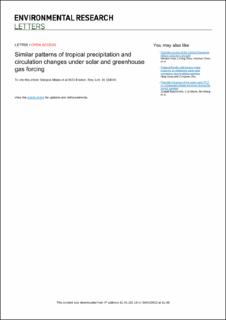| dc.contributor.author | Misios, Stergios | |
| dc.contributor.author | Kasoar, Matthew | |
| dc.contributor.author | Kasoar, Elliott | |
| dc.contributor.author | Gray, Lesley | |
| dc.contributor.author | Haigh, Joanna | |
| dc.contributor.author | Stathopoulos, Stavros | |
| dc.contributor.author | Kourtidis, Konstantinos | |
| dc.contributor.author | Myhre, Gunnar | |
| dc.contributor.author | Olivié, Dirk | |
| dc.contributor.author | Shindell, Drew | |
| dc.contributor.author | Tang, Tao | |
| dc.date.accessioned | 2022-01-31T09:48:01Z | |
| dc.date.available | 2022-01-31T09:48:01Z | |
| dc.date.created | 2021-11-30T14:46:13Z | |
| dc.date.issued | 2021 | |
| dc.identifier.citation | Environmental Research Letters. 2021, 16 (10), 1-11. | en_US |
| dc.identifier.issn | 1748-9326 | |
| dc.identifier.uri | https://hdl.handle.net/11250/2975872 | |
| dc.description.abstract | Theory and model evidence indicate a higher global hydrological sensitivity for the same amount of surface warming to solar as to greenhouse gas (GHG) forcing, but regional patterns are highly uncertain due to their dependence on circulation and dynamics. We analyse a multi-model ensemble of idealized experiments and a set of simulations of the last millennium and we demonstrate similar global signatures and patterns of forced response in the tropical Pacific, of higher sensitivity for the solar forcing. In the idealized simulations, both solar and GHG forcing warm the equatorial Pacific, enhance precipitation in the central Pacific, and weaken and shift the Walker circulation eastward. Centennial variations in the solar forcing over the last millennium cause similar patterns of enhanced equatorial precipitation and slowdown of the Walker circulation in response to periods with stronger solar forcing. Similar forced patterns albeit of considerably weaker magnitude are identified for variations in GHG concentrations over the 20th century, with the lower sensitivity explained by fast atmospheric adjustments. These findings differ from previous studies that have typically suggested divergent responses in tropical precipitation and circulation between the solar and GHG forcings. We conclude that tropical Walker circulation and precipitation might be more susceptible to solar variability rather than GHG variations during the last-millennium, assuming comparable global mean surface temperature changes. | en_US |
| dc.language.iso | eng | en_US |
| dc.publisher | IOPScience | en_US |
| dc.rights | Navngivelse 4.0 Internasjonal | * |
| dc.rights.uri | http://creativecommons.org/licenses/by/4.0/deed.no | * |
| dc.title | Similar patterns of tropical precipitation and circulation changes under solar and greenhouse gas forcing | en_US |
| dc.type | Journal article | en_US |
| dc.type | Peer reviewed | en_US |
| dc.description.version | publishedVersion | en_US |
| dc.source.pagenumber | 1-11 | en_US |
| dc.source.volume | 16 | en_US |
| dc.source.journal | Environmental Research Letters | en_US |
| dc.source.issue | 10 | en_US |
| dc.identifier.doi | 10.1088/1748-9326/ac28b1 | |
| dc.identifier.cristin | 1961874 | |
| cristin.ispublished | true | |
| cristin.fulltext | original | |
| cristin.qualitycode | 2 | |

